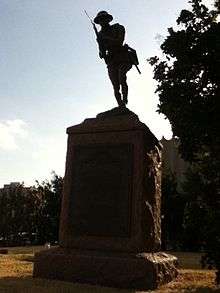Enid Downtown Historic District
|
Enid Downtown Historic District | |
| Location | Roughly bounded by Maple Ave., 2nd St., Cherokee Ave., and Adams St., Enid, Oklahoma |
|---|---|
| Area | 296 acres (120 ha) |
| Built | 1900 - 1957 |
| Architect | Layton, Hicks & Forsythe; Hawk & Parr, Don Wright, Louis A. Simon, Smith-Day, Davis and Davis |
| Architectural style | Art Deco, Classical Revival, Commercial, Mission/Spanish Colonial Revival, Colonial Revival |
| NRHP Reference # | 07001265[1] |
| Added to NRHP | December 12, 2007 |
The Enid Downtown Historic District is a 296-acre (1.20 km2), seven-block district located in Enid, Oklahoma and listed on the National Register of Historic Places since 2007. The district includes the original downtown plat from 1893, part of the Jonesville addition plat from 1898, and part of the Weatherly addition plat from 1902.[2]
Notable contributing buildings in the district include:[2][3]

- First National Bank of Enid, 201 N. Grand, 1922, Classical Revival
- Broadway Tower, 114 E. Broadway, 1931, Art Deco
- Enid Masonic Temple, 301 W. Broadway, 1924, Italian Renaissance Revival
- Woolworths building, 128 W. Randolph, 1921, Art Deco
- Montgomery Ward building, 102 W. Randolph, 1934, Colonial Revival
- Sears building, 116 E. Randolph, 1927, Commercial Style
- Shield building, 109 S. Grand, 1933, Mission/Spanish Colonial Revival
- Garfield County Courthouse, 100 W. Broadway, 1936, Art Deco
- United States Post Office and Courthouse, 115 W. Broadway, Classical Revival

Two statues are on the square also are contributing:[2]
- Doughboy statue, 1924 [lower-alpha 1]
- Statue of Liberty, set up in 1950 by the Boy Scouts of America
Jonesville, Oklahoma
On September 16, 1893, Walter M. Cook, a Chickashaw cowhand, mounted a pony at the Hennessey line, and arrived first at the Enid townsite, riding 18 miles (29 km) in under an hour.[4][5] He kept riding, and ultimately, the 22-year-old claimed 160 acres (0.65 km2) north of the town square.[4]
He was then followed by others, including Albert Hammer, Ben F. Clampitt, and William Coyle.[4] 300 squatters also soon occupied the land, calling it Jonesville, and platted the site as a separate town.[4] Jonesville was bordered by Grand on the west, 7th Street on the east, Walnut street on the north, and Randolph on the south which joined with the town square.[6] The portion of Jonesville included in the Historic District is along East and West Randolph, north of the square.[2] The property was estimated to be worth at least one million dollars in 1903.[7]
C.M. Hobbs, Eugene Kenyon and Peter Bowers made up the trust for the Jonesville group.[7] Clampitt, Coyle, and Hammer agreed to forfeit their claim in favor of a portion of the property if Cook lost his bid.[4] Cook built a house on his property, but the land was also occupied by the houses of several squatters. Mr. Cook left Enid, put his house up for mortgage in order to pay the dispute's legal fees. Ultimately, he left for six months, seeking assistance from the Chickashaw Nation.[4] He soon became ill with pneumonia, and came back to Enid, only to find his house demolished and his land overtaken by the squatters.[8] As a result of his leaving town, the Department of the Interior judged that Cook had abandoned his claim, and the Jonesville party won.[4][7] On March 6, 1895, the Jonesville citizens requested to be annexed by Enid.[6] Enid City Ordinance No. 57, passed April 3, 1895 allowed Enid to annex Jonesville.[9]
In 1898, at the age of 26, Cook became a Rough Rider in Cuba, as part of troop D.[4][8][10][11] He toured with a wild west show, married, had children, and opened a steakhouse.[4] Ultimately, Cook became a bootlegger when Oklahoma instituted prohibition in 1907, often going in and out of jail.[12] Cook died in 1936.[13]
Notes
- ↑ Incorrectly listed as E.M. Viquesney's Spirit of the American Doughboy on application for Enid's National Register of Historic Places; see Smithonian Inventory of American Sculpture record OK000196 for correct information.
References
- ↑ National Park Service (2009-03-13). "National Register Information System". National Register of Historic Places. National Park Service.
- 1 2 3 4 National Register of Historic Places Inventory/Nomination for Enid Downtown Historic District, #07001265 (PDF), National Park Service, 2007
- ↑ "Architectural/Historical Survey of Certain Parts of Enid," Meacham and Associates, 1992, page 31-32.
- 1 2 3 4 5 6 7 8 9 James, Marquis The Cherokee strip: a tale of an Oklahoma boyhood, p. 55-63, 278-280,
- ↑ Hadden, Briton and Luce, Henry Robinson, TIME Index, Volume XLVI, page 100
- 1 2 Rockwell, Stella, ed. "Jonesville," Garfield County 1893-1982, Vol II, Garfield County Historical Society, 1982, p. 814
- 1 2 3 "BIG MONEY INVOLVED, Civil Suit Taken Up in Enid Today. VALUABLE LAND TRACK, Albert Hammer Claims the First Filing. Case Will Test the Ownership Between Many Claimants – Land Is Valued At Over a Million Dollars", The Oklahoman, December 5, 1903]
- 1 2 "Architectural/Historical Survey of Certain Parts of Enid," Meacham and Associates, 1992, page 34.
- ↑ The Chronicles of Oklahoma, Oklahoma Historical Society, 1965, p. 168
- ↑ McGinty, Billy; Fulbright, Jim and Stehno, Albert, Oklahoma Rough Rider: Billy McGinty's own story, 2008, p. 91
- ↑ Jones, Virgil Carrington, Roosevelt's Rough Riders, Doubleday, 1971, p. 195
- ↑ "Cook v. State (No. A-2802) Criminal Court of Appeals October 3, 1917", The Pacific reporter, Volume 167, p. 641
- ↑ Rockwell, Stella, ed. "Race Winner...Claim Loser!," Garfield County 1893-1982, Vol II, Garfield County Historical Society, 1982, pp. 517-518.